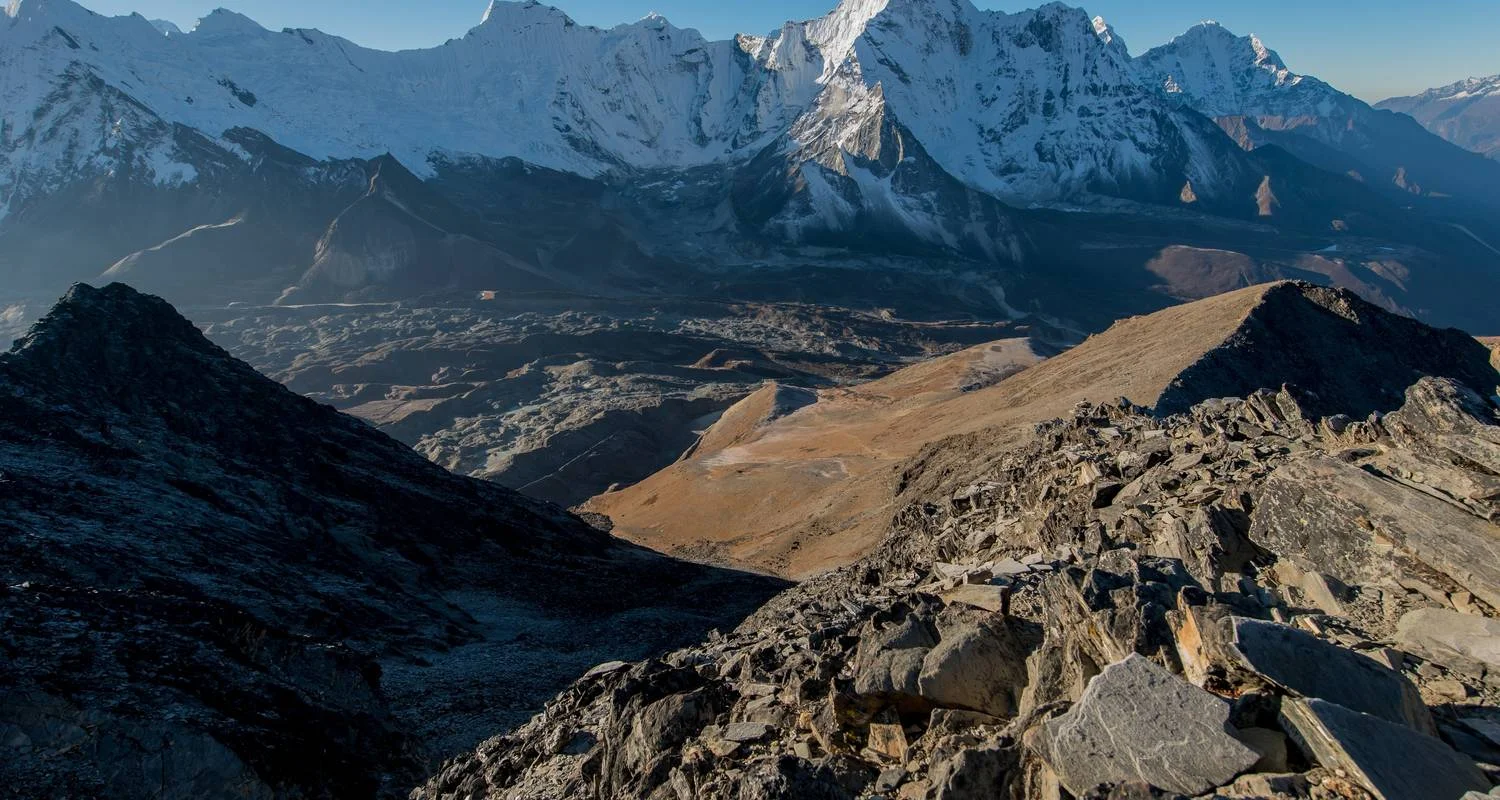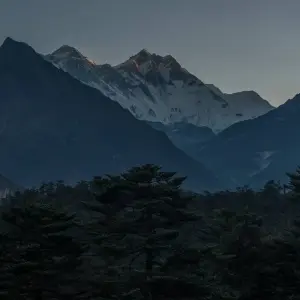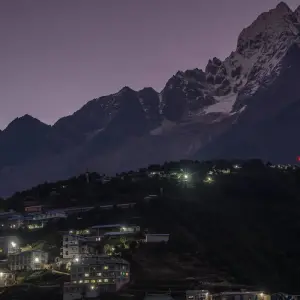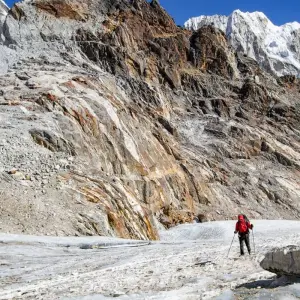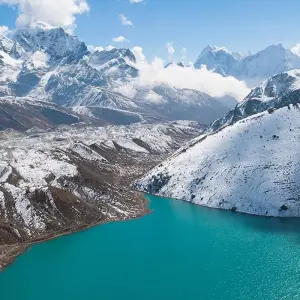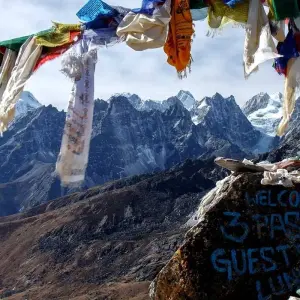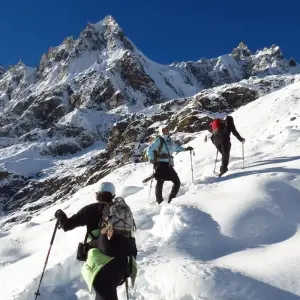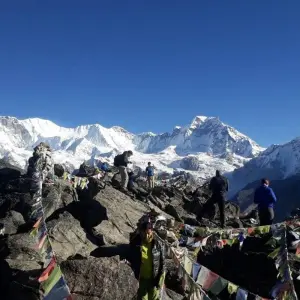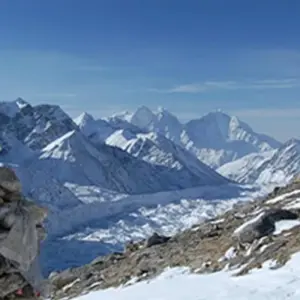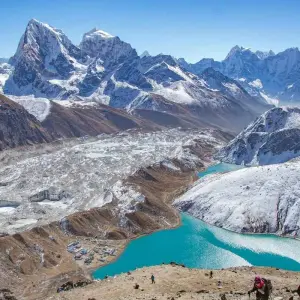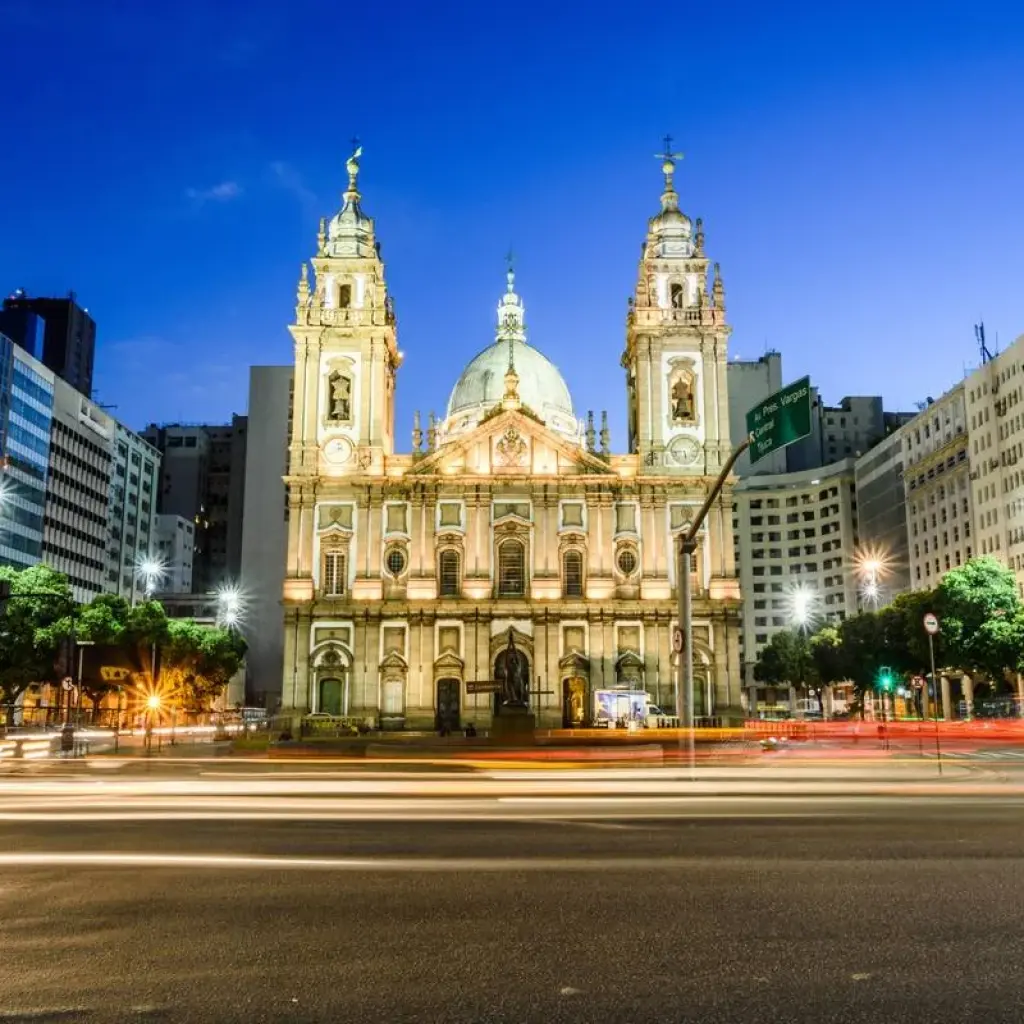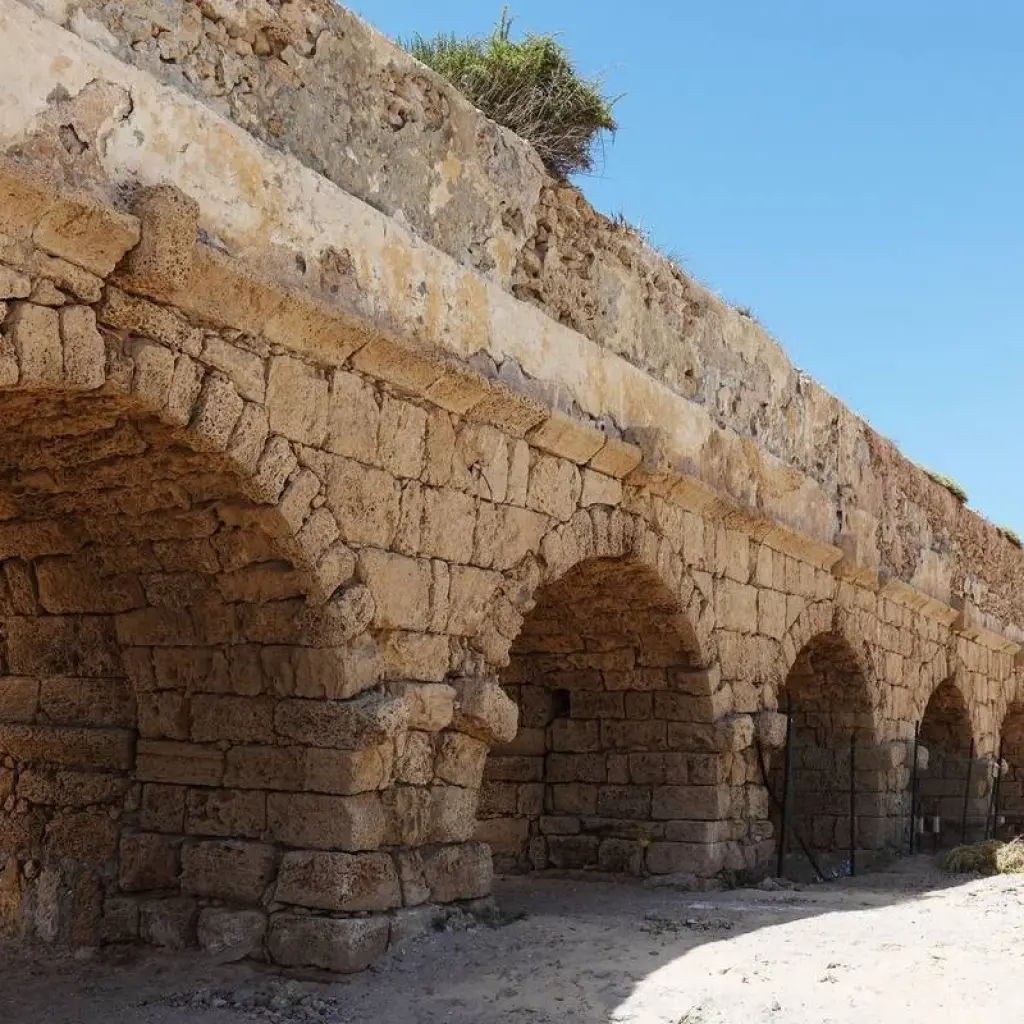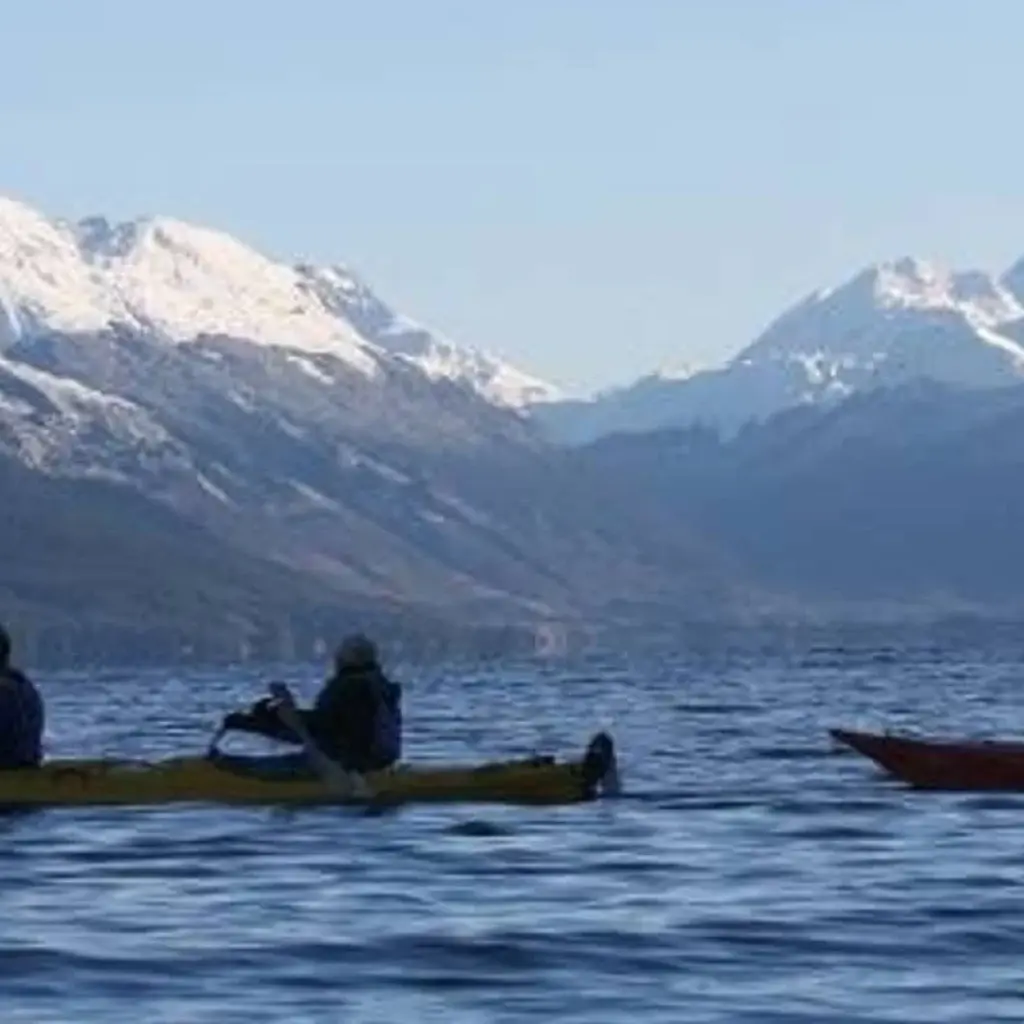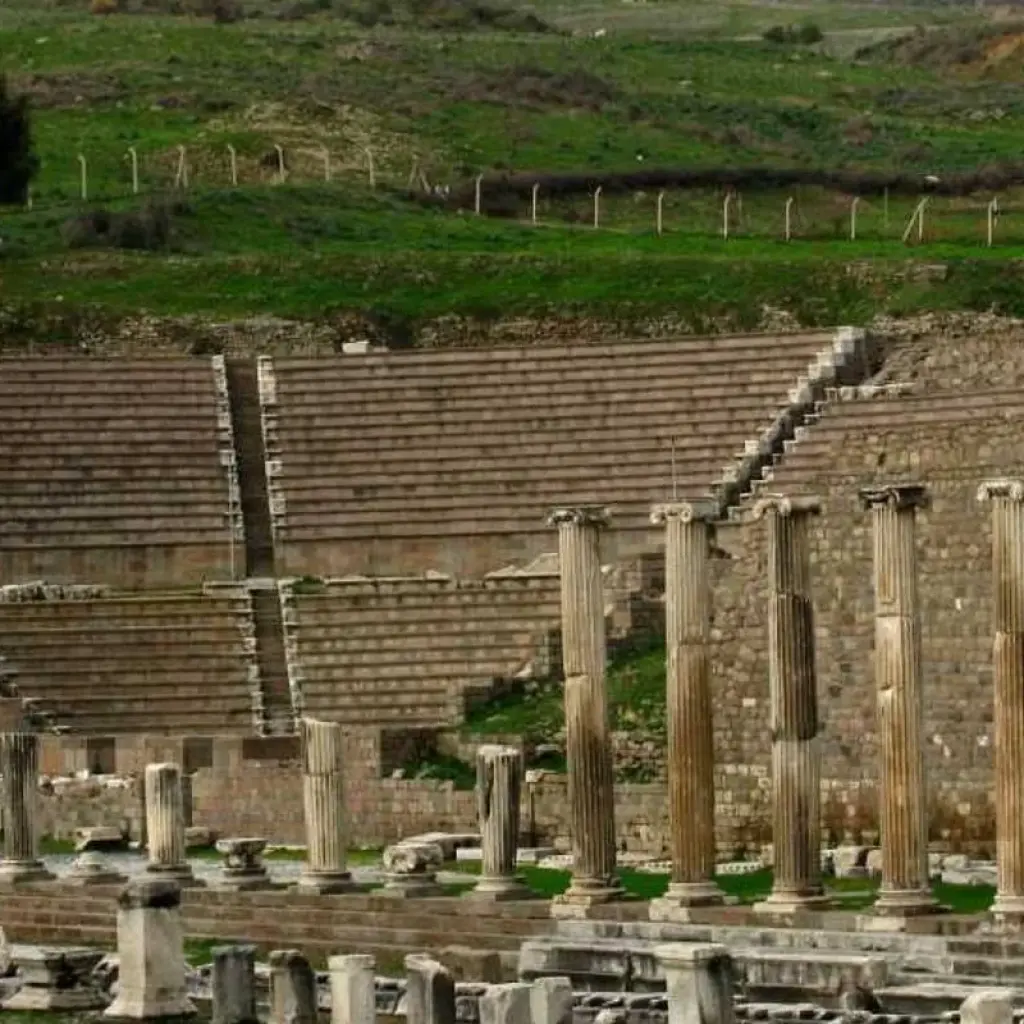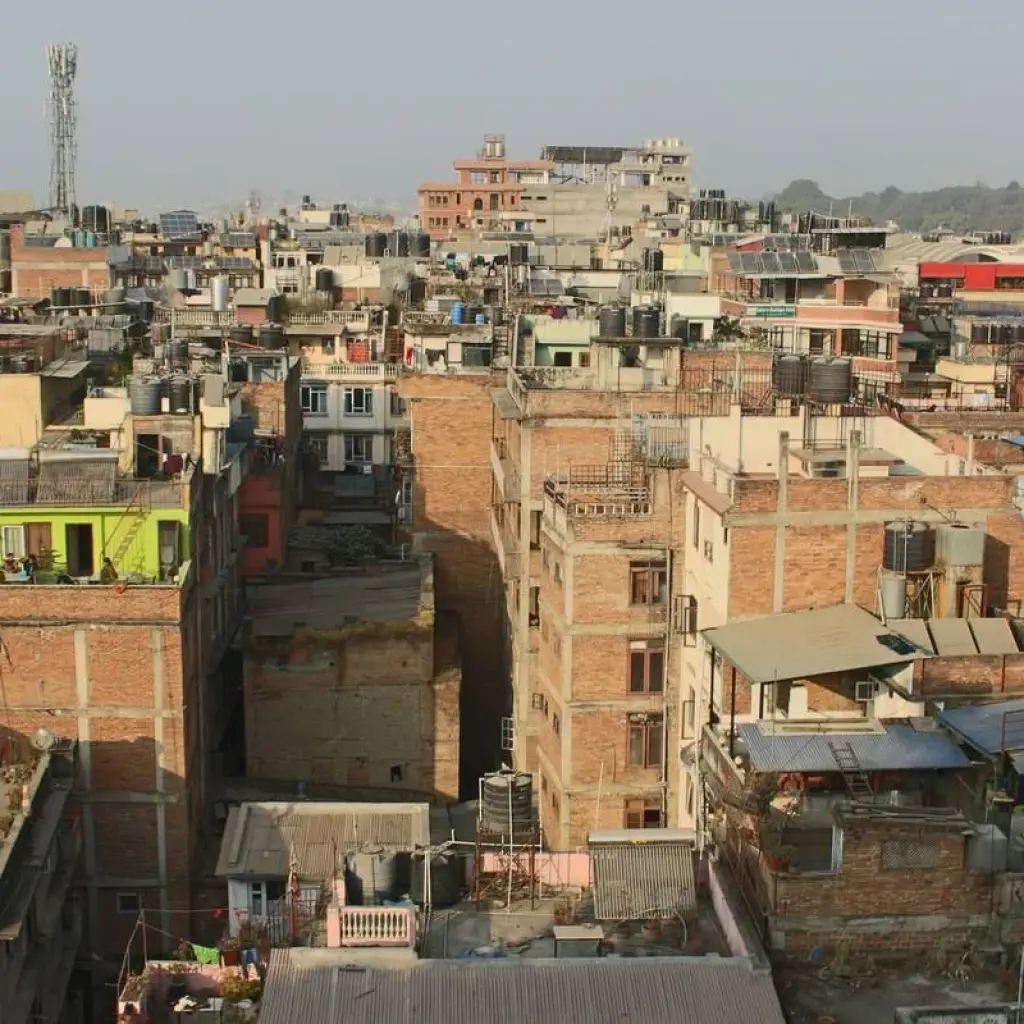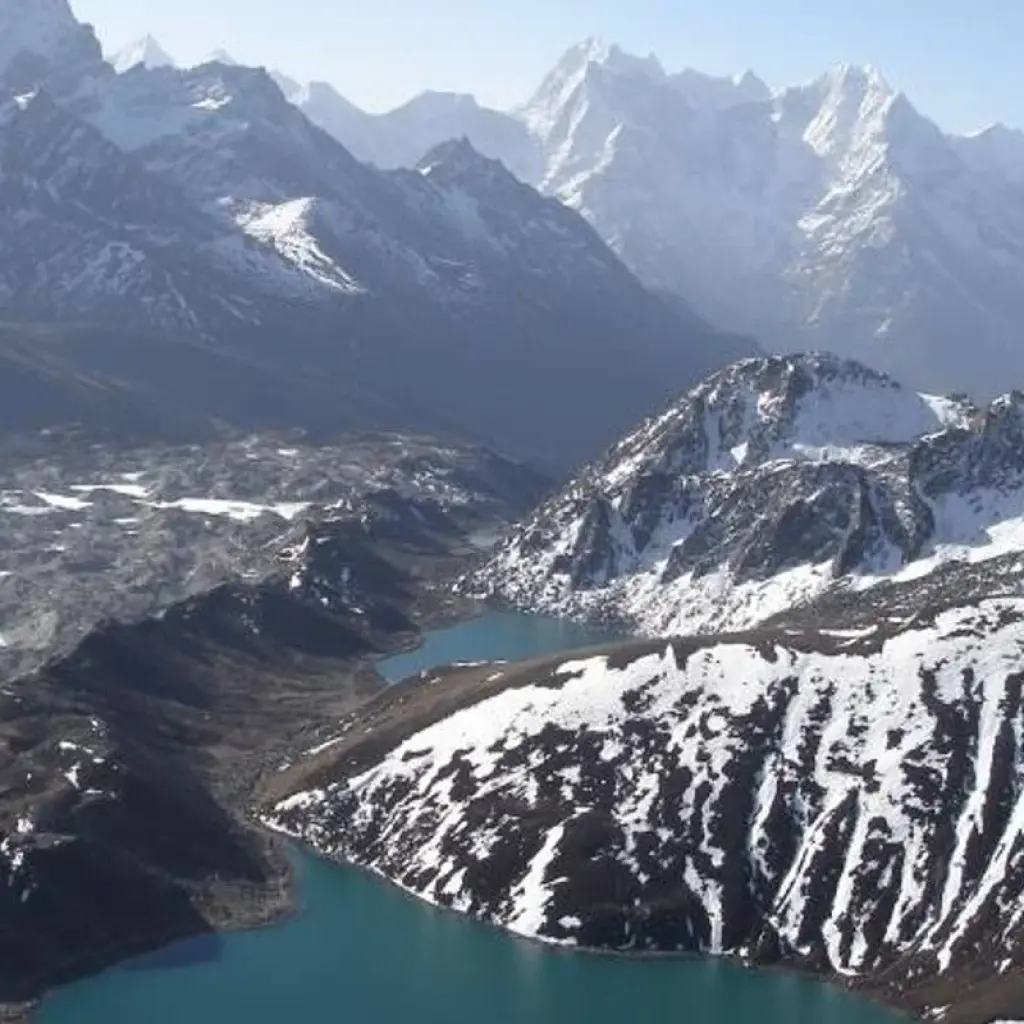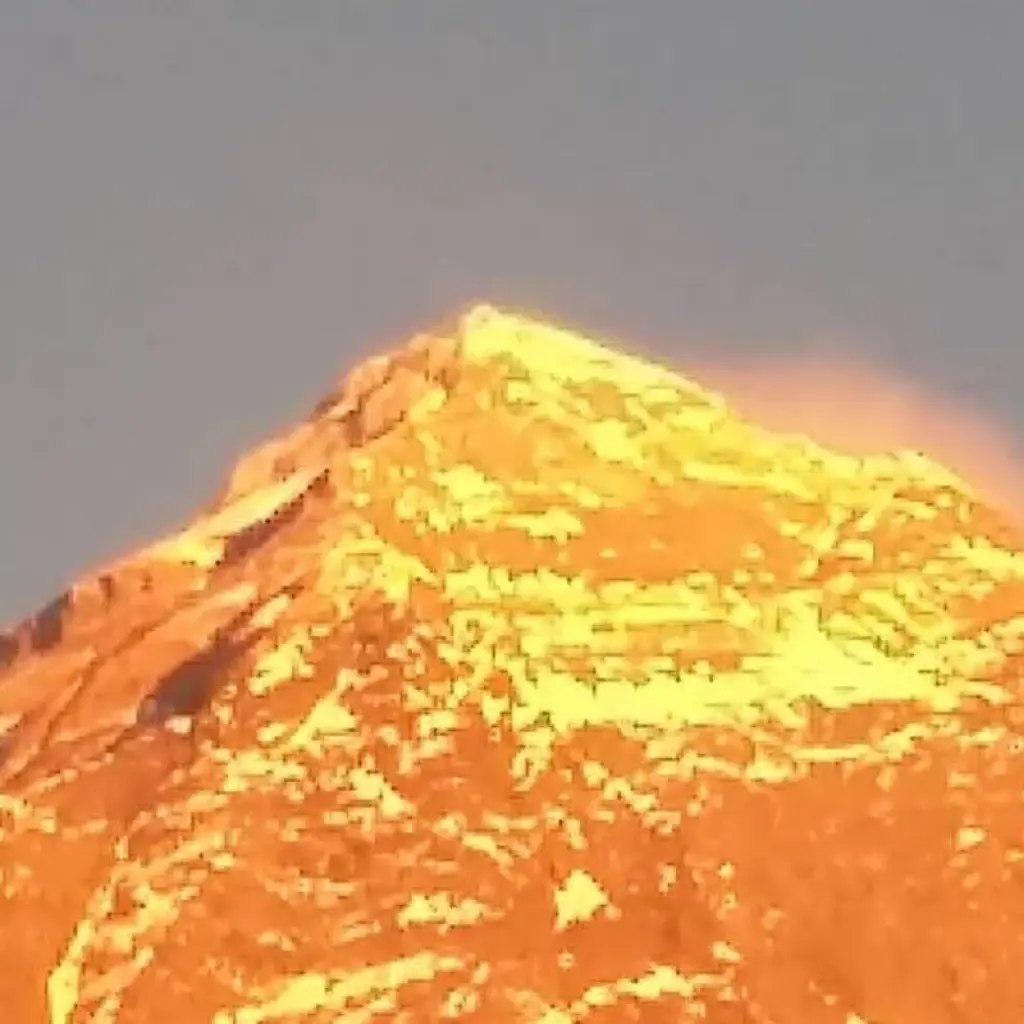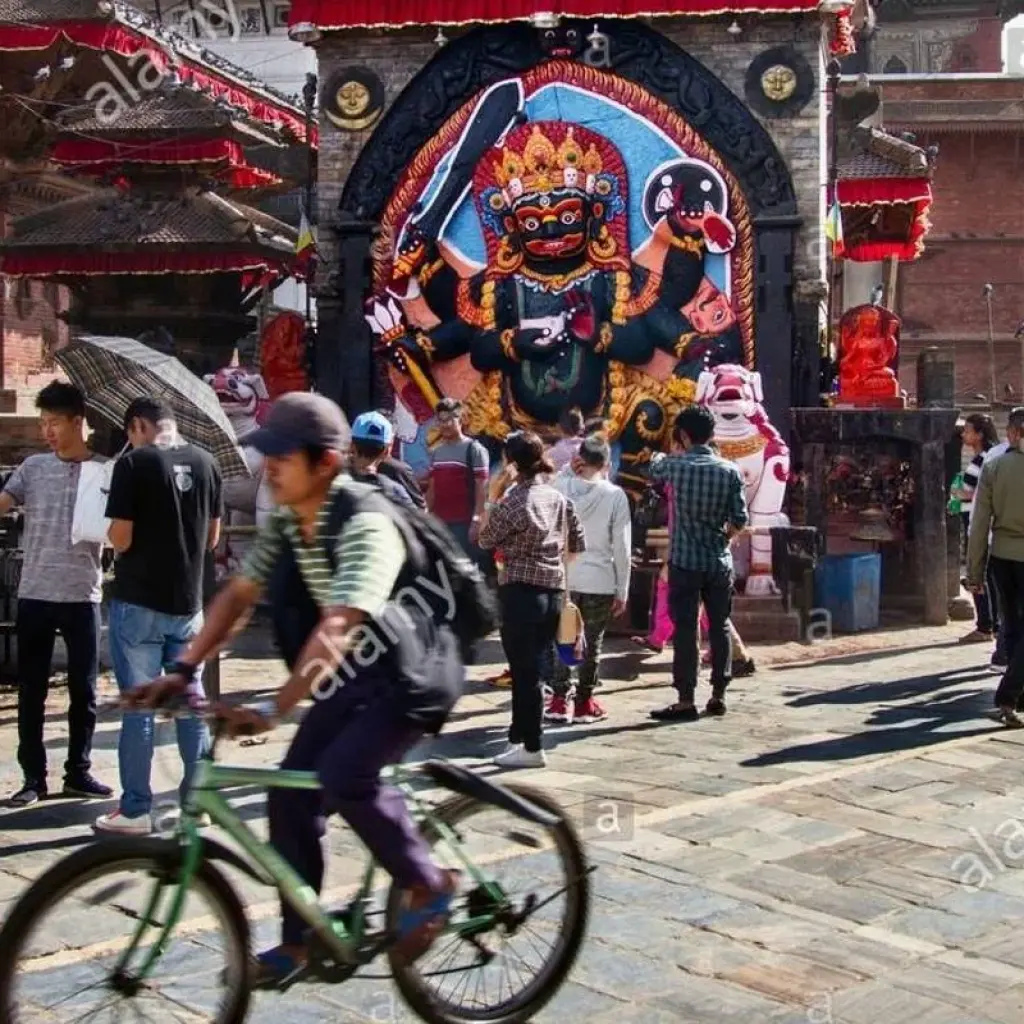Uw aankomst in Kathmandu wordt gemarkeerd door te landen op de Tribhuvan International Airport (TIA). Een bedrijfsvertegenwoordiger van Himalaya Adventure Treks & Tours ontvangt u en brengt u naar uw hotel. 's Avonds kun je de deelnemers en de trekleden ontmoeten. Overnachting in een hotel in Kathmandu.
Itinerary
HOOGTEPUNTEN
- Steek de 3 hoge passen over in de regio Everest.
- Kongma La Pass (5.535 m), Cho La Pass (5.420 m) en Renjo La Pass (5.360m).
- Ervaar de warme Sherpacultuur in verschillende dorpen zoals Namche en Tengboche.
- Uitzicht op zonsopgang over de Everest -reeks van Kala Patthar.
- Verken de prachtige Gokyo-meren.
Overzicht
De Everest Three High Passes Trek is een van de meest uitdagende tochten in de Khumbu-vallei. Zo trekt het veel trekkers aan met een dorst naar avontuur. De drie hoge passen die je tijdens de trektocht moet veroveren zijn respectievelijk Kongma La Pass (5.535 m), Cho La Pass (5.420 m) en Renjo La Pass (5.360m). Bovendien kunt u ook een bezoek brengen aan de Gokyo-vallei, die gevuld is met het prachtige Gokyo-meer. Tijdens de tocht kun je genieten van de warme Sherpacultuur en levensstijl.
De tocht duurt 20 dagen en begint met een vlucht van Kathmandu naar Lukla. Dan begin je via Phakding naar Namche Bazaar te trekken. Onderweg komt u ook het Sagarmatha National Park binnen. Vanuit Namche verken je ook het dorp Khumjung en Hotel Everest View (HEV). Je gaat oostwaarts richting Dingboche langs Tengboche onderweg. Nadat je de Kongma La Pass hebt overgestoken, ga je naar Everest Base Camp en bezoek je Kala Patthar (5.545m) het hoogste punt op deze trektocht. Daarna trek je naar de regio Gokyo nadat je de tweede pas hebt overgestoken, Cho La Pass. Daar breng je een volledige dag door om de Gokyo-meren en Gokyo Ri te verkennen. Ten slotte overwin je de laatste pas, Renjo La (5360m), en trek je naar het zuiden om Lukla te bereiken.
Omdat het een van de moeilijke uitdagingen van de Everest-regio is, moet je een geweldige fysieke conditie hebben. Het is dus het beste als je eerdere trekkingervaringen hebt. De beste tijd voor deze tocht is tijdens de maanden maart-mei en september-november.
Himalayan Adventure Treks & Tours biedt alle benodigde faciliteiten tegen betaalbare prijzen. Je hebt ook de vrijheid om je reisschema naar wens te wijzigen. We bieden u ook onze beste en professionele gidsen.
Tour program
Aankomst op de luchthaven van Kathmandu. (1300 m)
Start point
Tribhuvan International Airport, त्रिभुवन विमानस्थल, Kathmandu, Bagmati, Nepal
Vlieg van Kathmandu naar Lukla (2860m) en Trek naar Phakding (2610m) 3-4 uur. (B/L/D)
Op deze dag wordt u overgebracht naar de luchthaven voor een korte schilderachtige vlucht naar Lukla. Het is minder dan 30 minuten vliegen met een verbluffend uitzicht op bergen, bossen en riviervalleien. Na de landing in Lukla beginnen we 3-4 uur aan onze trektocht naar Phakding. Het pad leidt naar Phakding en geniet onderweg van het natuurlijke scenario.
Trek van Phakding naar Namche Bazaar (3446m) 6-7 uur. (B/L/D)
Op deze dag trekken we naar Namche Bazaar vanuit Phakding Village door de rivier Dudh Koshi. Het pad is aangenaam met het uitzicht op bossen van dennen-, dennen- en rododendronbomen. We bereiken Monjo, de ingang van het Sagarmatha National Park. Het uitzicht op reuzengebergte is indrukwekkend tijdens een wandeling door het pad.
Acclimatisatiedag bezoek Khumjung Village, Hotel Everest View (3880m). (B/L/D)
Het is een acclimatisatiedag in Namche, dus je hebt genoeg tijd om de levensstijl van de lokale bevolking te verkennen. Kort wandelen kan het gebruik van tijd zijn. Grote hoogte kan schadelijk zijn als we rust negeren. Het is noodzakelijk om je lichaam met hoge hoogte aan te passen. Bezoek Sagarmatha National Park en maak een wandeling naar Everest View Hotel. Op onze terugweg naar Namche Bazaar.
we maken ook een tour nee door de Khumjung. Klooster en Hillary School. Onze gids kan ons ook meenemen naar het Tourist Visitor Center nabij het hoofdkantoor van het Sagarmatha National Park, waar we een assortiment dingen kunnen observeren die verband houden met de eerste Everest-opklimmen, Sherpa-cultuur en meer te weten komen over de verschillende planten- en dierenleven in de Everest-regio. Je kunt's werelds verbazingwekkende panoramische scènes van de aarde bekijken vanuit het hoogste hotel ter wereld en de kans krijgen om uniek verschillende Sherpa-cultuur te observeren.
Trek van Namche Bazaar naar Tengboche (3860 m) 5 -6 uur. (B/L/D)
We beginnen met de trektocht van vandaag op een gemakkelijk pad naar Phunki Thanga. Vanaf hier stijgen we op naar het dorp Tengboche, dat de thuisbasis is van het grootste klooster in de regio Everest. Het klooster bevindt zich in het Sagarmatha National Park en biedt een panoramisch uitzicht op de hoogste bergen op aarde, waaronder Everest, Ama Dablam, Thamserku, Nuptse en Lhotse.
We proberen's middags het klooster te bereiken en kunnen misschien zelfs getuige zijn van een religieuze boeddhistische ceremonie.
Trek van Tengboche naar Dingboche (4360 m) 5 -6 uur. (B/L/D)
We beginnen met de trektocht van vandaag door bergafwaarts te wandelen en door weelderige bossen gevuld met berken, naaldbomen en rododendronbos. We vervolgen onze trektocht met een prachtig uitzicht op Mt. Everest, Lhotse en Ama Dablam om ons energieker te houden. Het pittoreske pad daalt naar Debuche, steekt de Imja-rivier over en brengt ons naar Pangboche. Tijdens het wandelen over de bovenste Pangboche paden krijgen we een ongerept uitzicht op de Himalaya en het Pangboche klooster.
We gaan verder richting de Imja-vallei, de rivier de Lobuche, en klimmen uiteindelijk naar Dingboche. Het dorp is een prachtige winderige nederzetting over het hoofd gezien door chortles en gebed Soeddhistische vlaggen overal op het klooster.
Acclimatisatie- en rustdag in Dingboche (4360 m). (B/L/D)
Dingboche is een populaire stop voor trekkers en klimmers op weg naar Mt. Everest, Ama Dablam (Imja Tse). Het dorp is prachtig met een scala aan velden omsloten door stenen muren om gerst, boekweit en aardappelen te beschermen tegen de koude wind en grazende dieren.
We brengen een dag door in Dingboche voor acclimatisatie. We maken een dagwandeling naar Nagarjun Hill voor een geweldig uitzicht op Makalu, Lhotse, Chalotse, Tawache, Ama Dablam en vele anderen.
Trek van Dingboche naar Chhukung (4750m), Beklim Chhukung Ri (5546m) 6-7 uur. (B/L/D)
Ons pad loopt door stenen ommuurde velden en Imja Khola-vallei voordat we gletsjermorenen binnengaan te midden van de torenhoge Himalaya. Het pad gaat verder naar Bibre, een jakherdersplaats. Vanaf hier ligt direct aan de overkant van de vallei de fantastische Ama Dablam en het Amphu Labsa-gebergte. Het pad dat voor ligt wordt doorsneden door ijzige beekjes. We vervolgen onze wandeling ongeveer een half uur en bereiken Chhukung.
Na de lunch beginnen we onze trektocht richting Chhukung Ri. De klim naar Chhukung Ri omvat wat makkelijke klauteren in de buurt van de top. Vanaf de top kunnen we direct over de vallei kijken voor een fantastisch uitzicht op de toppen van Ama Dablam en Amphu Labcha. We dalen terug naar Chhukung om de nacht door te brengen.
Overtocht naar Kongma La Pas (5528m) & Trek naar Lobuche (4940m) 6 -7 Uur. (B/L/D)
We beginnen de trektocht van vandaag heel vroeg in de ochtend om het hoogste deel van de hele reis te bereiken, namelijk de Kongma La Pass. We kunnen ofwel een pad nemen over een heuvel die ten noordwesten van Chhukung over de morenen van de Nuptse Gletsjer ligt of we kunnen teruglopen naar Bibre en wandelen over het pad boven de Niyang Khola. De bovenkant van de pas wordt gekenmerkt door cairns en boeddhistische gebedsvlaggen.
De laatste afdaling van de pas is het moeilijkste deel van de reis van vandaag. Na het beklimmen van de morene aan de andere kant draait het pad naar het noorden door de Khumbu gletsjer die ons naar Lobuche brengt.
Trek van Lobuche naar Gorakshep (5.170 m) bezoek EBC (5.364 m) 6-7 Uur. (B/L/D)
Ons pad beweegt langs de laterale morene van de Khumbu gletsjer. Verderop op het pad zien we de top van de noordelijke rand van Everest samen met Pumori, Mahalangur, Lingtern, Khumbutse, Nuptse en andere bergen. Een kleine beklimming brengt ons naar Thangma Riju. Vanaf hier bewonderen we een panoramisch uitzicht op het uitzicht op de Himalaya. We stijgen op een steil pad naar de top van de Changri gletsjer. Als we Gorakshep bereiken, worden we omringd door de Himalaya.
Na een korte tijd uit te rusten, gaan we verder naar Everest Base Camp. We passeren rotsachtige duinen, morenen en beken voordat we het basiskamp van's werelds hoogste berg, Everest bereiken. Vanaf hier bewonderen we de bergen Nuptse, Khumbuste en Pumori. We trekken terug naar Gorakshep en brengen de nacht door.
Trek van Gorakshep naar KalaPatthar (5.545 m), dan naar Lobuche (4.940 m) 8 -9 uur. (B/L/D)
We beginnen onze tocht vroeg in de ochtend naar Kala Patthar om een opmerkelijk uitzicht te krijgen op het eerste licht van de zon die schijnt op Mt. Everest. We moeten echter voorbereid zijn op trekking in de donkere en koude temperaturen (de temperatuur varieert afhankelijk van het seizoen). Bovendien is er altijd een kans op koude winden die vrij gebruikelijk zijn. Terwijl we onze trektocht voortzetten, torenen bekende pieken zoals Lingtren, Khumbutse, Changtse, Everest en Nuptse boven ons uit.
Na enkele uren beklimming staan we op de top van Kala Patthar. De close-up van Mt. Everest en andere Himalaya-pieken uit Kalapathar zijn geweldig. We genieten van het prachtige uitzicht op de Himalaya en dalen af naar Lobuche waar we overnachten.
Trek van Lobuche naar Dzongla (4.830 m) 3-4 uur. (B/L/D)
Vanuit Lobuche trekken we bergafwaarts over een pad langs de Khumbu gletsjer. Ons pad splitst zich in tweeën en we kiezen het pad aan onze rechterkant. Onderweg kunnen we het uitzicht op de dreigende Awi Peak beter bewonderen. We passeren een stoepa en grafstenen in de verte.
Na een tijdje lopen beginnen we te ascenderen. Tijdens de beklimming zien we het Chola Tsho-meer in de buurt. We gaan verder en passeren een ander meer dat veel kleiner is dan het Chola Tsho-meer. We steken de Chola Khola over op een brug voordat we Dzongla bereiken.
Trek van Dzongla naar Thangnag Kharka (4.270 m) via de Cho La Pas (5.368 m) 6 -7 uur. (B/L/D) rs
Naarmate we hoogte krijgen, begint het Cho La-meer te verschijnen en zit de Ama Dablam over een reeks bergen in het zuiden en Cholatse zweeft in het westen. Het beklimmen van de helling is niet eenvoudig; het is steil, maar verergerd door rotsblokken waarover we sommige zullen moeten klauteren.
De laatste klim naar de Cho La kan een beetje lastig zijn als het pad rond een spleet buigt. De bovenkant van de pas wordt gekenmerkt door gebedsvlaggen en cairns. Het landschap van majestueuze toppen in alle richtingen is adembenemend. Hoewel lang, is het pad dat naar Thangnak leidt niet moeilijk.
Trek van Thangnag Kharka naar Gokyo (4.800 m) 3 -4 uur. (B/L/D)
Na een goede nachtrust in Thangnag Kharka lopen we naar beneden naar de Gokyo-vallei. Ons pad brengt ons naar de rand van de Ngozumpa-gletsjer, de langste gletsjer van Nepal. Als we de andere kant van de gletsjer bereiken, zien we het tweede Gokyo-meer op de reeks van zes meren. Op korte afstand ligt het derde Gokyo-meer. Aan de rand van dit meer staat het dorp Gokyo waar we overnachten.
Rustdag in Gokyo & Beklim Gokyo Ri (5357m), Tour 4e en 5e Gokyo Meren. (B/L/D)
We beklimmen vandaag Gokyo Ri en genieten van het uitzicht op het ongelooflijke bergzicht. We kunnen vandaag ook het vierde Gokyo-meer bezoeken, dat slechts 3 km ten noorden van het Gokyo Village ligt. Ga vervolgens verder met wandelen naar het 5e meer. Het uitzicht vanaf 'Scoundell's Viewpoint', gelegen aan de rand van het 5e meer, is verbluffend. Cho-Oyu, Gyachung Kang, Everest, Lhotse, Nuptse en Makulu bergen en de enorme Ngozumbagletsjer zijn van ons om te bewonderen. We trekken terug naar Gokyo en brengen de nacht door.
Trek van Gokyo naar Marlung (4.210 m) via de Renjo La Pas (5.360 m) 7 -8 uur. (B/L/D)
We beginnen de dag vroeg in de ochtend om de lange tocht te voltooien. Ons pad beweegt een tijdje langs Dudh Pokhari (meer). We lopen ongeveer twee uur voordat we afdalen naar de Renjo Lapas. Onderweg worden we beloond met extravagante uitzichten op de Himalaya- en Rolwaling-reeksen en anderen. Het uitzicht vanaf de Renjo Lapas lijkt veel op die van Gokyo Ri met het derde Gokyo-meer en Gokyo Village onder het grijze uitstrijkje van de Ngozumpagletsjer.
We krijgen ook een prachtig uitzicht op Mt. Everest vanaf de top van de pas. Verder vanaf de pas slingert ons pad een stenen trap af en beweegt vervolgens over losse puin om de zuidelijke oever van het Angladumba Tsho-meer te bereiken. De aanwezigheid van ijs op het pad tijdens het afdalen kan onze afdaling een beetje gevaarlijk maken.
Onderweg zien we Relama Tsho en Renjo Lake. We lopen door een smalle vallei verstopt met gigantische rotsblokken naar Lumde waar een steunhut is, maar deze is vaak gesloten. We lopen bijna een uur van Lumde om Marlung te bereiken op de oostelijke oever van de rivier de Bhote Koshi.
Trek van Marlung naar Namche Bazaar (3.446 m) 5-6 uur. (B/L/D)
De afdaling van Marulung naar Thame volgt een traditionele route die eeuwenlang door de Tibetaanse handelaren wordt gebruikt. We steken de Bhote Koshi rivier over en dalen af naar Taranga. Het pad blijft dalen en we steken twee bruggen over voordat we Thame bereiken. Met uitzicht op Thame is de beroemde Gompa gelegen op een heuvel in het westen. Vanaf hier dalen we geleidelijk af op een pad dat door een paar kleine dorpjes loopt voordat we de Namche Bazaar bereiken, waarschijnlijk de grootste stad in de regio Everest.
Trek van Namche Bazaar naar Lukla (2.860 m) 6 -7 uur. (B/L/D)
We beginnen onze tocht met een afdaling. Terwijl we onze tocht voortzetten, steken we verschillende bruggen over over de snelstromende Dudh Koshi-rivier en zijn zijrivieren. Nu is het pad gelijkmatiger en natuurlijker geworden. Tijdens onze trektocht genieten we van wandelen op open vlaktes, door rododendron- en dennenbossen en genieten we van verre uitzichten op de met sneeuw bedekte toppen.
We lopen door Sherpadorpen en merken hun indrukwekkende geloof in het boeddhisme en de cultuur van gebedsstenen en gebedsvlaggen op. Nadat we Lukla hebben bereikt, strekken we die pijnlijke benen uit en herinneren we ons de ervaringen van de afgelopen weken. Onze lange tocht naar de berg en zijn hoge passen eindigt vandaag.
Vlieg van Lukla naar Kathmandu. (B/D)
De vluchten naar Kathmandu worden meestal's ochtends gepland voor veiligheidsdoeleinden. Na het bereiken van de Kathmandu. We kunnen even uitrusten in onze hotelkamer of souvenirs kopen voor onze familie en vrienden.
's Avonds hebben we een afscheidsdiner in een authentiek Nepalees restaurant met culturele prestaties.
Vertrek naar de luchthaven. (B)
Een vertegenwoordiger van Himalaya Adventure Treks and Tours brengt u ongeveer 3 uur voor uw geplande vlucht naar de luchthaven. Op weg naar huis heb je genoeg tijd om je volgende avontuur in het prachtige land Nepal te plannen.
End point
Tribhuvan International Airport, त्रिभुवन विमानस्थल, Kathmandu, Bagmati, Nepal
Tour Details
accommodation
- Two Night 3* hotel in Kathmandu met ontbijt.
- Alle accommodaties in lodges/theehuizen tijdens de trektochten.
flights
- Vliegticket (LUK-KTM-LUK) /binnenlandse luchthavenbelasting.
guide
- Een ervaren, behulpzame en vriendelijke gids, portier (1 portier alleen voor 2 klanten)
insurance
- Reis- en reddingsregelingen.
meals
- Ontbijt in Kathmandu.
- Lunch, diner en ontbijt tijdens trekking.
optional
Equipment List for Everest Three High Passes Trek:
Everest Three High Passes is difficult trekking but however our long-year experience of operating Trekking to Nepal, We learn many things and would like to give some information to pack your equipment list for your Everest Three High Passes Trek and we hope, this information will be helpful you so success your trip.
Luggage/Duffle bag:
You will require a duffel bag or a backpack for trekking (65- 75 L) max and all our trekking stuff are kept in this duffle bag and this will be carried by our porters. However, Himalayan Adventure also provides the duffle back if needed.
A day backpack:
You will need a day backpack and you will be carrying it every day by yourself and we recommend you it has to be at least 25L and you can carry important documents like Passport, credit card along with a need to carry a water bottle, snacks bar and clothing layers (hat, gloves, fleece, sunblock, poles, etc…).
Trekking/Hiking boots:
Everest Three High Passes is difficult to trek and It is very important to have good trekking boots and it should be waterproof (in case of snow, or rain) Make sure it should be fit on your feet and comfortable during walking. Also, recommend you bring the Crompton during the winter season in Nepal.
Sport Sandals:
You need to have a pair of sports shoes or sandals to use while you are in camp or tea houses after the trek.
Sneakers:
Everest Three High Passes is difficult trekking so sneakers are not suitable for this trek so you can leave your sneakers in Kathmandu hotel until you get back.
Sleeping Bag:
You need to have a lightweight sleeping bag that works for the minus 15 degrees for the summer season but during the winter we recommend minus 20 degrees for the Everest Base camp trek. Himalayan Adventure can provide it if you need one but has to be returned after the trek.
Fleece jacket:
You need to have good quality fleece jacket at least 1 synthetic jacket or pullovers are a great alternative to fleece because they are lighter and more compressible and gives you enough warmth during the trekking.
Down jacket:
Down jacket is compulsory and recommend you to bring the warm enough so can keep you warm during the Everest Three High Passes Trek.
Socks:
You need to have at least 6 pairs of thick socks during the spring & autumn but winter and monsoon need at list 8 pairs of socks for the Everest Three High Passes Trek.
Lightweight/ warm insulated pants:
You need to have at least 4 pairs of lightweight trekking pants like Lightweight expedition thermal bottoms, Nylon hiking shorts, Softshell and hardshell trekking pants, Water/windproof trousers, and Casual pants so we can use as the weather.
Short-sleeved shirts:
You need to have 4 ice-breaker merino wool to keep you warm from the cold or synthetic shirts and if you are not allergic to wool products, merino wool is the ideal for Everest Three High Passes Trek.
Long-sleeved shirts:
You need to have at least three shirts.
Underwear:
You need to have few pairs of underwear and this can be as much as you need as there are no washing facilities every day on Everest Three High Passes Trek, we highly recommend you to have enough pair of underwear.
Waterproof jacket:
You need at least one waterproof jacket for the rain/snow and wind for the Everest Three High Passes Trek and waterproof pants may be on option.
Head and face gear:
Sun Hat or cap during the day time, Woolen Hat for morning & Evening and Polarized sunglasses are compulsory.
Hand gear:
You need warm gloves.
Traveling supplies:
Adapter Plug for Charging the Camera and Mobile, Camera belt, Passport belt ( nice to have), Swiss army knife (option), Flashlight, Headlamp, Water bottle, Extra camera battery, Hand sanitizer, Alarm clock, Hiking poles (optional ) and Binoculars (optional).
Toiletries:
Razor, razor blades, shaving cream, aftershave toothbrush, toothpaste, dental floss, sunscreen, toilet paper, small towel, and period pads (for women).
Medication:
First Aid Medical Kit box (can be purchased in Thamel Kathmandu), Altitude Medicines (Diamox), Tylenol, aspirin, ibuprofen, Anti-diarrheic, Powerful antibiotics, and Nasal Spray or Drops.
Physical Fitness:
Many people have questions as to what level of physical fitness is required for trekking in Nepal and that is extremely reliant on what activity the visitor is engaging in Nepal With that said, for a standard easy trek to Extreme hard level of trekking. The daily activity (trek) would be 5-6 hours,(depend on the trekking trail) and elevation will generally not exceed 5,600 meters like Everest Base Camp, Throng la passes, Chola passes treks and other passes or Base Camp but some of them are less than 4000m. The trekking day is involving both long steep climbs, and descents with a variety of terrain underfoot from well-trodden paths, to rocks covered with ice or snow, depending on the season. Mostly a day would include a number of climbs or descents of 600 meters more or less, starting after the early morning breakfast, resting at a lunch place in the afternoon, then continuous trekking until arriving at the teahouse.
In preparation for the trekking in Nepal, it is important, to begin with, the basic training requirement at least 2 months before departing for trekking in Nepal. Two to three hours of aerobic exercise like running, walking, swimming, cycling & some gym work per week is the minimum and most will find it beneficial to add some basic strength training to their physical fitness routine required for the hard trekking and for normal and easy trek just have some physical fitness is enough. One of the best ways to prepare is to take practice hikes with a daypack roughly the same weight as what you will be taking during the trek. Your calf should be enough fit and prepare for trekking. Mostly during the trekking calf paining or tired is the main issue. Do this only after a baseline of fitness has been reached. Moving fast is not our goal, will provide a more enjoyable and safe adventure trekking in Nepal for all easy and hard level.
Trekking Seasons in Nepal:
There are main two seasons in which Nepal where the most amount of visitors visit. (September, October & November) being the most popular season which is also called the peak season in Nepal, and spring (March, April & May) coming in close behind which is also called the mini-season in Nepal. The summer months of June, July, and August are the monsoon season and most of the time raining as such the trails are mostly washed out sometimes, and roads can sometimes be impassible due to landslide activates. Nevertheless, you can trek to rain-shadow regions like Upper Dolpo and Upper Mustang during the monsoon seasons. Nepal is a suitable destination for all seasons.
Winter is very dry & extremely cold and all the high passes become inaccessible due to ice and snow conditions. The temperature doesn’t usually fluctuate during the day time temperature is around 20-25 degrees. However, you gain the altitude the temperature decreases. The temperature can drop to around 0 to -25 degrees at night when staying at tented camps in Himalayan regions. Winter trek in higher altitudes is not advised due to the danger of avalanches and also altitude sickness. Although some may enjoy the sight of the snow-covered mountains as you reach your destination. However, the temperature does not change as much in lower mountain regions the nights are slightly colder than days’ time.
Autumn & Spring is the best timing for trekking in Nepal because the weather is generally warm and dry, and flowers are in bloom in the lower elevations of the country on the same time you can see the many festivals during that period.
Trekking Day:
A typical trekking day begins with the early morning breakfast around 7 am in the hotel. (Depend on the trekking region). It would advise you to pack your trekking gears in a duffle bag and essential supplies in your day pack after having breakfast; we begin the trek and head along the trail at around 8 am. The morning walk is more energetics to be longer as we begin with refreshed bodies and enthusiasm. A good morning’s walk, we make a stop for lunch at around 11-12 pm. The lunch involves group meals enjoying the vicinity around the stop & enjoys the organic & local food in the mountain. After resting for about an hour or two, we resume our trek to reach teahouse or camp by 2-3 pm. The afternoon walk is relatively shorter and can involve games and side trips as organized by the trekking experienced guides. You also can enjoy breaks during the trek to relax, read, and stroll around the area or doing yoga. You can explore with the local people and observe their lifestyle & culture. Dinner is served around 7-8 in the evening to round off the day.
Meals and Accommodations:
During the trekking period, the accommodation is commonly referred to as teahouses. These are family-run basic lodges that fill the role of the restaurant, Dining hall, and boarding house for tourists. Now a day’s electricity can be found in the rooms, which mean one light bulb, and one or two outlets for charging electronics. The common areas are also lit by electricity. Alternatively, teahouses may also use solar, hydroelectric, or have electrical lines running into the village, so the commonality and availability of electricity may vary. Still, a few of the trekking route electricity service is not available. Use the local traditional kerosene light.
Most of the teahouses have private rooms, though if the trek is in a more remote or high altitude place there are limited teahouses so season time dormitories are the norm. Most of the room has 2 single beds with basic bedding, and the bathroom is shared. Some of the places we can get the private bathroom also with a mix of western and squat style toilets in the bathrooms.
Breakfast and dinner are taken at the same teahouses and these lodges have large family style dining rooms centered on a stove or coal to provide heat basically in mountain areas. Most of the areas menu will have Nepali style western foods such as Pancake, pizza, Burger, fries, etc. Also on the menu is the traditional Nepali food Dal Bhat meal. This is a lentil soup with rice, vegetable, Pickle, or meat curry. Most menus will also offer a smattering of local cuisine.
Internal Flight Delays:
Nepal is an incredible and beautiful country of mixed of the White Mountains, deep valleys, Landscape, rivers, and green rolling hills. With this incredible diversity of landscapes, road travel can be extremely time consuming and flights within Nepal to reach popular trekking destinations is the easiest way. Not all the trekking destination has flight service, so road transportation is the only option. Mountainous terrain also comes with the possibility of in-climate weather. It mentions the incredibly high number of visitors during peak seasons makes internal flight delays a genuine possibility. To manage this situation, it may be helpful to have a few extras days on either end of your tour. If any cancellations or flight delays do occur (high chances of flight delays from around Kathmandu to Lukla, Everest region, Pokhara to Jomsom, Annapurna region), we also provide services to arrange chopper on the last stage to help you to be on your schedule on the premises of Civil Aviation Rules in Nepal which state that helicopters can fly if the visibility is 1500m. The cost ranges from USD400 to USD650 according to the number of passengers. The payment can be made either to the helicopter company or to us directly and can be made either by cash or using a credit card. It will be beneficial to purchase and review your insurance, the insurance companies may cover some of the alternative measures of travel. Flight insurance may cover changing your international flight if it is necessary.
Travel Insurance:
Most expeditions, Adventurous trekking, and tours require that travel insurance and it is purchased prior to arriving in Nepal, but other normal treks and tours may not require. However, travel insurance is definitely an important consideration. There are a number of reasons to consider insurance. Firstly, it may be required, so check to see what is being asked for by the company. Second, Nepal is a landlocked country, and there are only a few direct flights. Travel in and out from country can encounter some disruptions if purchasing insurance, make sure flight delays and cancellations also included. Always choose insurance that, though every safeguard is in place during your Holiday, there are always extenuating circumstances that may result in an accident during trekking & tours. Read carefully printout of insurance policies to ensure that the trekking or any other activity you are engaging in is covered or not, as some policies have stopped covering trekking in certain places. If you are going above 5000 m or high always mention the policies so it’s cover the chopper service in the last condition. It is very important that if you have the comfort of good insurance, so do the research and choose carefully which makes your trip relaxing and joyful.
Nepal Visa Entry Procedure:
There is only one International airport which is the Tribhuvan International Airport in Nepal. Immigration Office, TIA (Tribhuvan International Airport) under the Department of Immigration has been facilitating tourists flying to Nepal by providing Visa on Arrival.
‘On Arrival’ visa procedure is very quick and simple. October, November, March, April can expect some queues during peak Tourist season and October is basically the Nepalese got the Main festival Dashain. You can also get Visa from Nepalese Diplomatic Missions stationed abroad prior to your arrival. The choice is yours.
Visa obtains from Nepalese Diplomatic Missions, and then you must enter Nepal within six months from the visa issued date. Your total stay is counted starting from the day you enter into Nepal.
Visas obtained on Arrival at the Entry and Exit points are ‘Tourist Visas’. They bear multiple Re entry facility. Tourist Visa ‘On Arrival’ is the only entry visa to Nepal. If you are visiting Nepal for the purposes other than Tourism (sightseeing, tour, travel, mountaineering, trekking, visiting friends and families), you should still get ‘Tourist Visa’ to get into the country. However, you must change the category of visa as per your purpose and length of stay in Nepal from the Department of Immigration by producing required documents.
Please click below for the online Visa form.
http://online.nepalimmigration.gov.np/tourist-visa
The following visa rules apply for tourists:
For 15 days Multiple Entry Visa, the visa fee is the US $30 or equivalent foreign currency.
For 30 days Multiple Entry Visa, the visa fee is the US $ 40 or equivalent foreign currency.
For 100 days Multiple Entry Visa, the visa fee is the US $ 100 or equivalent foreign currency.
According to the immigration regulations, a tourist is allowed to stay in Nepal only for 150 days in a year. You can extend the visa up to another 90 days.
US$ 2 or equivalent Nepalese currency per day for extension.
Additional US$ 25 or equivalent Nepalese currency on visa fee, if Multiple Entry facility is required for the extended period
For more details please visit our FAQ link
https://www.himalayanadventuretreks.com/faq/
Acute Mountain Sickness (AMS):
Acute Mountain Sickness (AMS) is usually seen in un-acclimatized people shortly after ascent to high altitudes. The condition occurs due to the thinning of air as the altitude increases. The condition, if not taken seriously and treated immediately, can be life-threatening and its symptoms can be seen generally above 3200 meters. The symptoms of Acute Mountain Sickness are nausea, vomiting, tiredness, shortness of breath, and cerebral pain. The itineraries are designed to properly acclimatize you to the change in high altitude climate and sufficient precautionary measures too are taken to take utmost caution for our valuable guests. Our staff also equipped with cell phones and satellite phones (Option) in the occurrence of any emergency cases. We are greatly driven to keep the safety and security of our clients as our foremost concern.
Drinking-Water:
Water is essential for life, and clean water is imperative while on holiday. When visiting the less developed countries like Nepal it is a concern that all travelers should consider. There are few options when trekking or traveling in Nepal that will mitigate any chances of drinking contaminated water. The first consideration to take into account is that tap water should not be ingested. That even means when brushing your teeth in an urban area. Most will choose to buy bottled water and if doing so make sure the cap has sealed properly. Plastic bottle reuse is a big problem, and with that being said there are other options on the market to assist in making water drinkable. Mountain spring water is drinkable but if you use the purified tablet. The conservation area project also sells this tablet most of the trekking area. A guide will assist you to find out it also.
Arrival Instruction:
Upon your arrival at Tribhuvan International Airport (TIA) Kathmandu Nepal, our company representatives are stationed to welcome you to the country. We request you to carefully look for your and company name placard being held by our representatives following the events upon landing. Our representatives will be responsible to escort you up to your hotel in Kathmandu. There are many brokers, Taxi drivers, and trouble maker people offering you to carry your luggage and take you to your destination as you exit from the gate. We request you to pay no attention to these people and follow the company representatives and follow their instructions.
How to Book Your Tour:
Before booking any tour or trekking please read all the terms and conditions thoroughly and call or email the company representative with any questions prior to making any payments. Begin by filling out a booking form and pay the non-refundable deposit. Fill out the form completely and if any confusion contacts the company person so as not to disrupt the expediency of the process. The form may be submitted online or by downloading the form and mailing or Whatsapp the form to your company representative.
It is very important to understand all aspects of the chosen trip, from what’s included and excluded, to the level of service, or even what trip may be right for your level of experience and fitness. Take the time to get all the questions answered so that when booking the trip, it is without trepidation.
others
- Ophalen van de luchthaven en transfer naar het hotel.
- Two Night 3* hotel in Kathmandu met ontbijt.
- Lunch, diner en ontbijt tijdens trekking. Vergunning voor
- nationaal park, vergunning voor het informatiebeheersysteem van Trekkers (TIMS).
- Alle benodigde papierwerken.
- De binnenlandse luchthaven wordt opgehaald en neergezet met een privévoertuig.
- Vliegticket (LUK-KTM-LUK) /binnenlandse luchthavenbelasting.
- Alle accommodaties in lodges/theehuizen tijdens de trektochten.
- Een ervaren, behulpzame en vriendelijke gids, portier (1 portier voor 2 klanten).
- Reis- en reddingsregelingen.
- Medische benodigdheden (EHBO-doos is beschikbaar).
- Last Night afscheidsdiner in een authentiek Nepalees restaurant met een culturele voorstelling.
- Visumkosten voor Nepal die u gemakkelijk kunt verkrijgen op de luchthaven van Kathmandu.
- Internationale vliegtickets van en naar Kathmandu.
- Extra overnachting Hotelaccommodatie in Kathmandu vanwege vroege aankomst, laat vertrek, vroege terugkeer van de berg (om welke reden dan ook) dan de geplande reisroute.
- Alle maaltijden in Kathmandu (en ook in het geval van vroege terugkeer van de berg dan de geplande reisroute).
- Alle kosten in berg boven dan gepland omdat ze soms vast kunnen zitten in de berg vanwege slecht weervertraging, vlucht of om welke reden dan ook.
- Reis- en reddingsverzekering.
- Persoonlijke uitgaven (telefoontjes, wasgoed, barrekeningen, batterijopladen, extra dragers, fles of gekookt water, warme douche, enz.).
transport
- Ophalen van de luchthaven en transfer naar het hotel.
- De binnenlandse luchthaven wordt opgehaald en neergezet met een privévoertuig.
Good to know
Currency
Nepalese Rupee
Nepal

